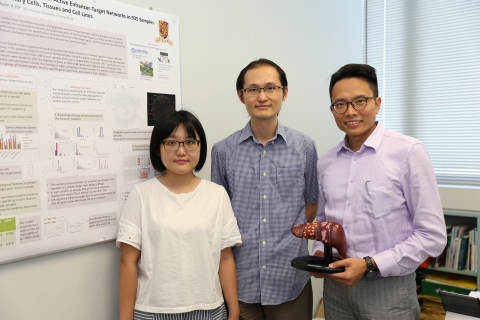A research team led by Prof. Kevin Yip has recently studied gene enhancers, a type of regulatory element in deoxyribonucleic acid (DNA), together with their target genes, in 935 human cell and tissue samples. This finding helps explain the consequences of mutations in enhancers. As an application in a cancer study, three genes (PSRC1, RBM24 and TERT) were found to be differentially methylated at their enhancer regions in liver cancers. A research article describing these works has been published in the internationally renowned journal Nature Genetics. The corresponding data generated in the study are open for free access, aiming at advancing relevant academic and medical research. Cancer is a genetic disease in which abnormal cells divide in an uncontrolled way, affecting normal body function. Traditionally, a strong emphasis in cancer research has been on studying how gene mutations are related to the formation of cancer. In contrast, understanding of mutations that happen at the intergenic regions of DNA has been limited. Genes are DNA segments that can produce ribonucleic acid (RNA) through a process called transcription, and these include the well-known protein-coding genes. Enhancers are DNA sequence elements that can be bound by a specific type of proteins and enhance the transcription of target genes. Typically, when a gene is not active, its DNA is chemically modified by a process called methylation, which suppresses transcription and reduces the synthesis of RNA and protein. Under certain circumstances, some genes and their enhancers can be abnormally de-methylated, which can lead to aberrant transcription and production of proteins that consequently transform a normal cell into tumor cell. Prof. Yip’s team performed a ground-breaking in-depth study of enhancers. They found that specific relationships between enhancers and genes can be identified through the analysis of a large amount of relevant data, thereby inferring the target genes of enhancers in each cell and tissue type. The research team made use of data from 935 human samples, including various cell and tissue types of biomedical importance, which represent the largest data set used, in comparison to similar studies. A novelty of the research is the consideration of interactions between different enhancers, an idea that gave rise to an effective method for identifying multiple enhancers that affect the same gene but with their effects shadowing each other. As the first application of the enhancer findings, Prof. Alfred Cheng in the School of Biomedical Sciences at CUHK, compared the experimental data obtained from normal human liver and cancer cells, and identified three genes whose enhancers are affected by DNA de-methylation in liver cancers, namely PSRC1, RBM24 and TERT. These results demonstrate an approach to narrow down the search for candidate liver cancer genes, which may help develop therapeutic strategies that target enhancer methylation. According to Prof. Yip, he will next apply the research results in the studies of nasopharyngeal carcinoma and diabetic complications, two projects led by CUHK Faculty of Medicine and funded by the Hong Kong Research Grants Council Theme-based Research Scheme, with a total funding amount of a hundred and ten million dollars. This study exemplifies a fruitful inter-disciplinary collaboration between the Department of Computer Science and Engineering and the School of Biomedical Sciences, CUHK. The data generated in the study have already been made freely accessible to the public and are contributing to different areas of biomedical research. Scientists can extract the enhancer-target networks most relevant to their target diseases for efficient identification of putative disease-related enhancers and their target genes for further investigations. The research article, ‘Reconstruction of Enhancer - Target Networks in 935 Samples of Human Primary Cells, Tissues and Cell Lines’ has been published online at the Nature Genetics web site since early September. It can be accessed at http://dx.doi.org/10.1038/ng.3950.
|
|


